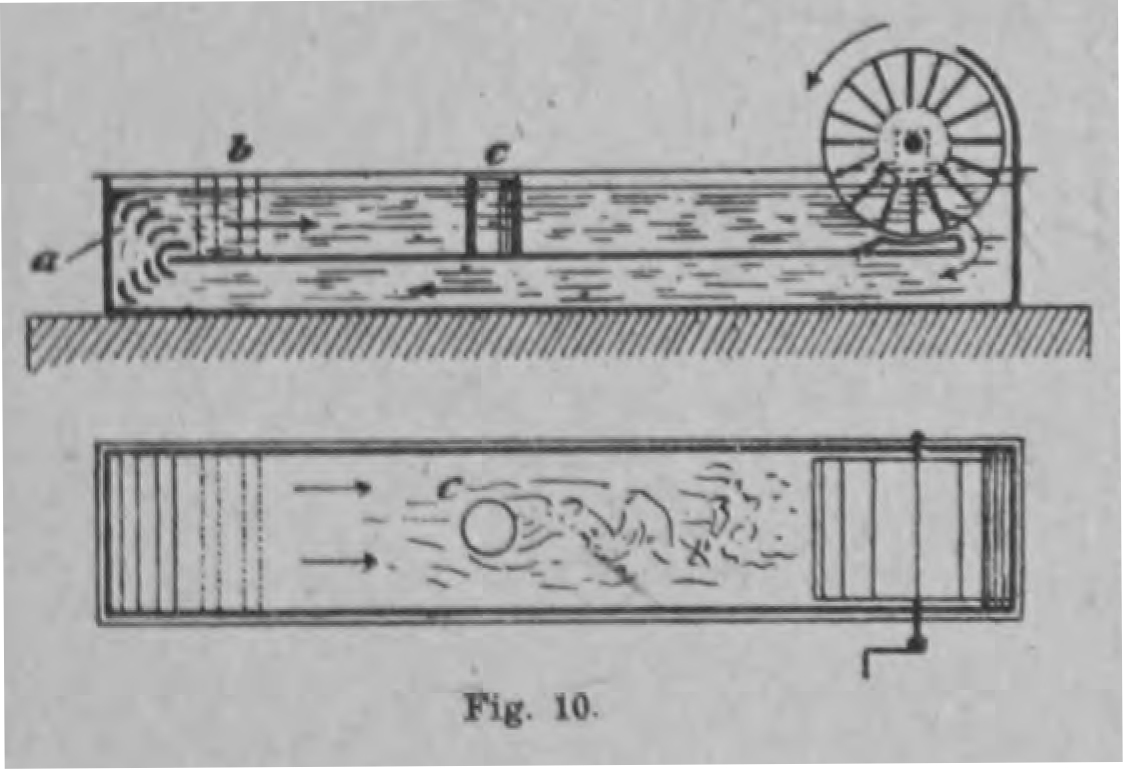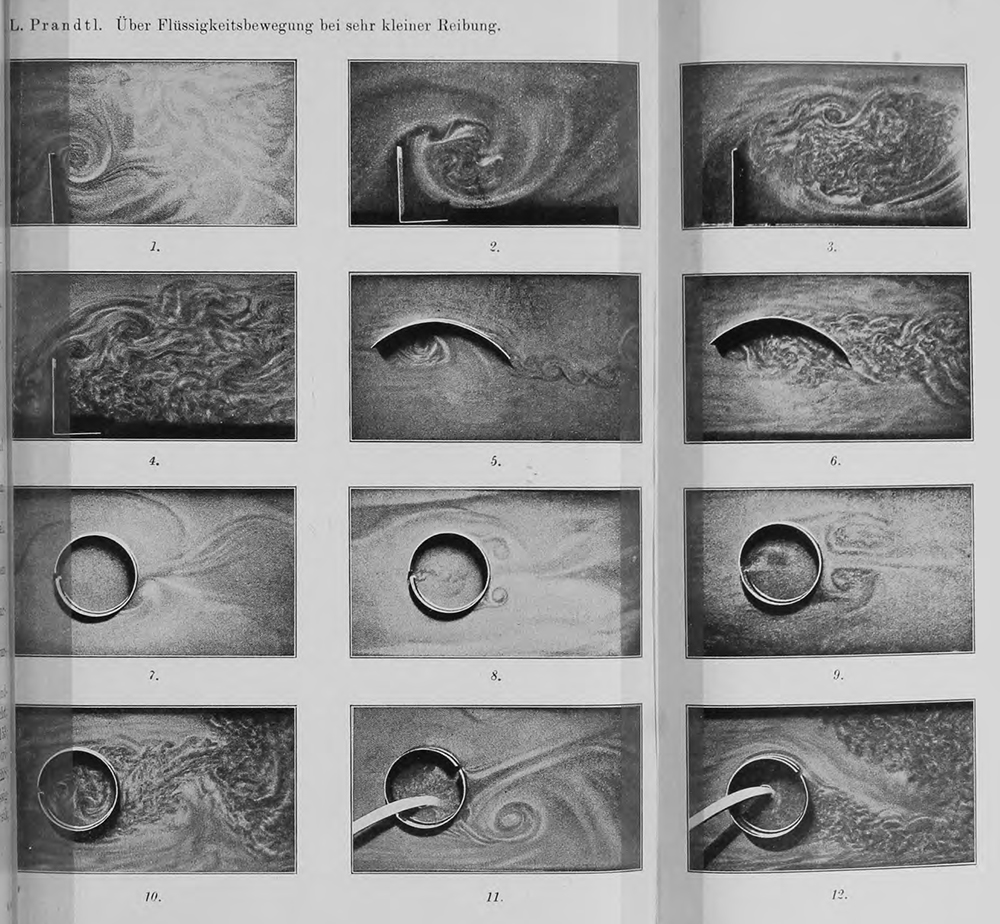Ludwig Prandtl, “Motion of Fluids with Very Little Viscosity” (1904)
Abstract
In this article, engineer Ludwig Prandtl discusses the “motion of fluids with very little viscosity,” that is the flow of water or air. Prandtl was particularly interested in the behavior of low-viscosity substances when they bumped up against “the surface of the solid body” and in the special role of the “boundary layer.” His research focused not only on flow patterns but also on the resulting vortices, which represented an important area of work in fluid mechanics and dynamics.
Source
In classical hydrodynamics, the motion of non-viscous fluids is predominantly discussed. For the motion of viscous fluids, we have the differential equation whose evaluation has been well confirmed by physical observations. As for solutions to this differential equation, we have, aside from one-dimensional problems like those given by Lord Rayleigh (Proceedings of the London Mathematical Society 11, page 57 = Papers I, page 474 ff.), only those in which the inertia of the fluid is disregarded or plays no important role. The two-dimensional and three-dimensional problem, taking viscosity and inertia into account, still awaits solution. The reason for this probably rests in the troublesome properties of the differential equation. […]
By far the most important aspect of the problem is the behavior of the fluid on the surface of the solid body. Sufficient account can be taken of the physical phenomena in the boundary layer between the fluid and the solid body by assuming that the fluid adheres to the surface and that, therefore, the velocity is either zero or equal to the velocity of the body. If, however, the viscosity is very slight and the path of the flow along the surface is not too long, then the velocity will have its normal value in immediate proximity to the surface. In the thin transition layer, the great velocity differences will then produce noticeable effects despite the small viscosity constants.
[…]
I will now briefly report on experiments that I undertook for comparison with the theory. The experimental apparatus (Fig. 10) consists of a tank that is 1.5 m (nearly 5 feet) long with an intermediate bottom. The water is set in motion by a paddle wheel. After passing through the deflecting apparatus (a) and four sieves (b), it enters the upper channel comparatively free from vortices; the object to be tested is introduced at c. Fine scales of micaceous iron ore are suspended in the water. These scales indicate the nature of the flow, especially as regards the vortices, by the peculiarities of their reflection due to their orientation.

Fig. 10 (from the original German)
The accompanying photograms [see below] were obtained in this manner. In all of them the flow goes from left to right. Photograms 1-4 show the flow of movement on a wall projecting into the current. The separating or boundary layer, which starts from the edge, is apparent. In No. 1 it is still very small; in No, 2, it is already concealed by strong disturbances; in No. 3, the vortex spreads over the whole picture; No. 4, shows the “stationary state.” A disturbance is also evident above the wall. Since a higher pressure prevails in the corner, due to the obstruction of the water flow, even here the flow separates from the wall after a while (Cf. Figs. 1-4), The various stripes visible in the vortex-free portion of the flow (especially in Nos. 1-2) are due to the fact that, at the inception of the flow, the liquid was not completely still. Nos. 5-6 show the flow around a curved obstacle or, from another viewpoint, through a continuously narrowing and then widening channel. No. 5 was taken shortly after the inception of the flow. One boundary layer has developed into a spiral, while the other has become elongated and broken up into very regular vortices. On the convex side, near the right end, the beginning of the separation can be seen. No. 6 shows the stationary state in which the flow begins to separate approximately at the narrowest cross section.
Nos. 7-10 show the flow around a circular-cylindrical obstacle (a pile). No. 7 shows the beginning of the separation; Nos. 8-9, subsequent stages. Between the two vortices there is a line of water that belonged to the transition layer before the beginning of the separation. No. 10 shows the state of inertia. The wake of turbulent water behind the cylinder swings back and forth, hence the momentary unsymmetrical shape. The cylinder has a slot along one of its generatrices. If this is placed as shown in Nos. 11-12 and water is sucked from the inside of the cylinder with a tube, the transition layer on one side can be intercepted. When this is absent, its effect, the separation, must also be absent. In No. 11, which corresponds to No. 9 in point of time, one sees only one vortex and the line. In No. 12 (stationary state), the flow closely follows the surface of the cylinder till it reaches the slot, although only a very little water enters the cylinder. A turbulent layer has developed instead on the flat wall of the tank (a first indication of this phenomenon having already appeared in No. 11). Since the velocity must decrease in the widening flow opening and the pressure consequently increase (½ ϱv2 + V + p = constant on every streamline), we have the conditions for the separation of the flow from the wall, so that even this striking phenomenon is explained by the theory presented.

Photographs 1-12 (from the original German)
Source of English translation: L. Prandtl, “Motion of Fluids with Very Little Viscosity” (translated by Dwight M. Miner), in Vier Abhandlungen zur Hydrodynamik und Aerodynamik. Göttingen, 1927. National Advisory Committee for Aeronautics, Technical Memorandum No. 452. Washington, DC: National Advisory Committee for Aeronautics, 1928, pp. 1–10. Available online at: https://ntrs.nasa.gov/archive/nasa/casi.ntrs.nasa.gov/19930090813.pdf
Source of original German text: Ludwig Prandtl, “Über Flüssigkeitsbewegung bei sehr kleiner Reibung.” Special issue of the “Verhandlungen des III. Internationalen Mathematiker-Kongresses Heidelberg 1904.” Druck und Verlag von B. G. Teubner, Leipzig, 1905, pp. 484–91, in Ludwig Prandtl, Albert Betz, Vier Abhandlungen zur Hydrodynamik und Aerodynamik. Neudruck aus den Verhandlungen des III. Internationalen Mathematiker-Kongresses zu Heidelberg und aus den Nachrichten der Gesellschaft für Wissenschaft zu Göttingen. Unveränderter Nachdruck der Ausgabe von 1927. Göttingen: Im Selbstverlag der Aerodynamischen Versuchsanstalt Göttingen E.V., 1944, pp. 2–8.